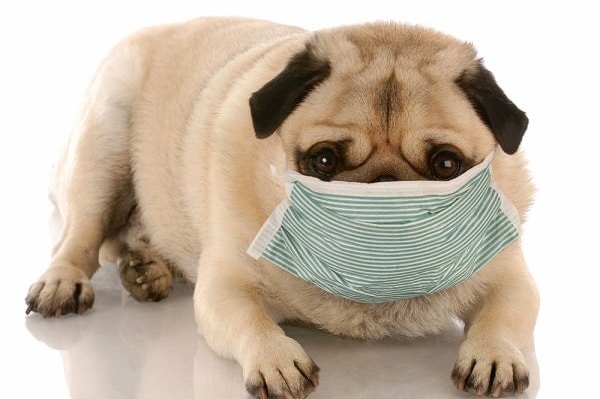Why is My Dog Vomiting White Foam? Here’s What to Know.

[ad_1]
Is your dog vomiting white foam? Bearing witness to your dog vomiting white foam can be disconcerting at the best of times and cause dog owners to panic at the worst. There are so many reasons for digestive upset in dogs, and they share so many similar symptoms, that general upset can be difficult for veterinarians to diagnose quickly. While some of the causes for this issue — such as a dog finding rotting food in the garbage or ingesting a foreign object — can occur to any dog at any time, you can manage, treat or prevent the riskiest and most dangerous reasons for a dog vomiting white foam.
First, why is your dog vomiting white foam?
Why is your dog vomiting white foam? Photography © MartinPrescott | E+ / Getty Images.
A dog who gets sick once before returning to normal is likely to have eaten something she shouldn’t. If a dog throws up several times in a day or for more than a couple of days in a row, on the other hand, schedule a veterinary appointment. The leading causes for a dog vomiting white foam include internal injury, infection and inconsistent eating habits. The major ones we’ll examine include:
- Ingesting toxins, poisons, foreign objects
- Bilious vomiting syndrome
- Bloat
- Kennel cough
- Pancreatitis and other digestive inflammations
- Parvovirus
- Rabies
1. A dog vomiting white foam may have eaten something strange
Eating a foreign object can lead to an upset stomach, indigestion or intestinal blockages, all of which might reasonably point to a dog vomiting white foam. With the exception of dog toys, small, loose objects should be kept well out of the reach of indoor dogs. Household items that are toxic to dogs — especially household cleaners that not dog safe and pesticides directed toward insects or rodents — can also cause adverse reactions, like a dog vomiting white foam.
Store all household chemicals in tightly-capped, shatterproof containers and never leave them out. If you put out rat, roach or mouse traps, put them in spots out of your dog’s reach. Here is a list of plants and foods that can be toxic to dogs. Note the presence of any of these in your home. It may be of critical importance to a veterinarian if a dog is vomiting white foam.
2. Your dog might be throwing up foam because of Bilious vomiting syndrome
Bilious Vomiting Syndrome in dogs is similar to acid reflux in humans. Bile and stomach acid are naturally occurring fluids that aid in the digestion and processing of food. On an empty stomach, however, they can cause irritation. That irritation can lead an otherwise healthy and hungry dog to ignore meals, or, in more extreme situations, vomit to expel the excess. The vomit from Bilious Vomiting Syndrome can be colored yellow, white, green, orange, brown or some mixture. Sometimes, it’s accompanied by slimy mucus.
Feeding an active dog smaller meals at regular intervals throughout the day — including a small snack first thing in the morning and last thing at night — may be the best and easiest way to address what could become a more serious problem. If excess stomach acid or bile are at fault, over the course of her life, a dog who produces excess digestive fluids can suffer from damage to her stomach or intestinal lining, leading to more serious digestive issues as she ages.
An alternate solution is acid-reducing medications. Consult with your dog’s veterinarian, who can recommend an antacid which may also help relieve your dog’s suffering, especially if your work schedule prevents you from being able to physically give your dog meals throughout the day.
3. Bloat may cause dogs to vomit white foam
Bloat, also known as gastric torsion or stomach dilation, is an extremely serious condition in dogs. In the worst cases, a dog’s stomach literally becomes twisted from its normal position in the abdomen. This not only traps air, food and fluids in the stomach, but it also restricts blood flow.
One of its early symptoms, before all movement into and out of the stomach cuts off, is a dog vomiting white foam. This condition most commonly occurs in deep-chested adult and senior dogs. While the precise reasons for it are unclear, prevention consists mainly of making sure dogs are not overactive just after meals.
4. A dog vomiting white foam can be a sign of kennel cough
Kennel cough is a mild illness, most commonly contracted in multi-dog households, at boarding facilities, veterinary offices, dog parks, and places where training classes are held. Wherever a large number of dogs are present, this upper respiratory infection can strike.
If a dog throwing up white foam has recently been in one of these situations, a veterinarian may reach a diagnosis much more quickly. Other symptoms to look out for are a hacking cough and eye discharge, or a runny nose. Kennel cough also tends to be a self-limiting sickness, typically running its course in about two weeks.
5. Pancreatitis might cause dogs to vomit white foam
Swelling or inflammation of the pancreas interrupts a dog’s normal digestive functioning. When food cannot be properly and regularly broken down, processed and eliminated, the dog has limited options for getting rid of the excess material in his stomach. Vomiting is one route, and white foam can accompany it.
Dogs with canine diabetes are at increased risk for developing pancreatitis, which is when white foam in the vomit is also linked to diabetes. Other symptoms include adopting a hunched-over position, noticeable abdominal pain and fever.
6. Parvovirus may cause foamy vomit in dogs
A viral infection seen most frequently in puppies and very young dogs who live in multi-dog homes, dogs get parvo through oral contact with feces. Signs of this illness generally begin within a week to 10 days of exposure to the virus.
Along with your dog vomiting white foam, the most alarming symptom of parvo is diarrhea that contains blood and has a strong odor. This is a deadly disease; however, most early-life combination vaccines help puppies build up immunity to parvovirus. An unvaccinated dog vomiting white foam may indicate parvo as the cause. Consult a vet as soon as possible.
7. A dog vomiting white foam might have rabies
Rabies is the last, and least likely, culprit for a dog vomiting white foam. We’re all familiar with the image of a rabid dog foaming at the mouth, but regurgitating foam only happens in the very last stages. By the time a dog takes to vomiting white foam, observers will have noticed much more worrisome signs, such as aggressive behavior. As with parvo, rabies is preventable with the appropriate vaccines and boosters.
The bottom line on a dog vomiting white foam:

The two most dangerous reasons why dogs vomit white foam are actually preventable. Photography by WilleeCole Photography / Shutterstock.
An informed, observant and proactive dog owner has a distinct advantage. This means knowing your dog’s eating habits, noting any deviations, and being able to adjust as circumstances require. Changing the portions and frequency of a dog’s meals, whether she is a growing puppy or an active adult, can help prevent the buildup of bile and acid, which causes later-in-life digestive problems.
Keeping a dog in a clean environment— including regularly sanitized food and water bowls— minimizes the risk of contracting parasites as well as bacterial infections. The two most dangerous reasons for a dog vomiting white foam — parvo and rabies — are largely preventable with proper vaccination.
Tell us: Has your dog ever vomited white foam? What was the reason for your dog vomiting white foam?
Thumbnail: Photography © Lindsay_Helms | iStock / Getty Images Plus.
This piece was originally published in 2010.
About the author
Melvin Peña trained as a scholar and teacher of 18th-century British literature before turning his research and writing skills to puppies and kittens. He enjoys making art, hiking, and concert-going, as well as dazzling crowds with operatic karaoke performances. He has a one-year-old female Bluetick Coonhound mix named Idris, and his online life is conveniently encapsulated here.
Learn more about how to decipher what your dog is throwing up on Dogster.com:
[ad_2]
Source link






